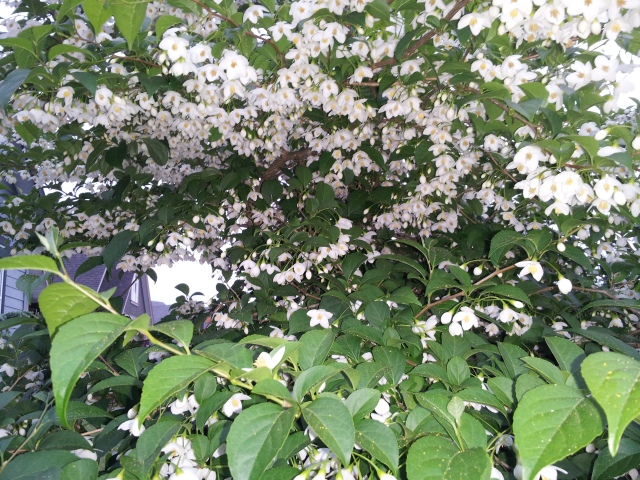This pretty little tree is another one of my (many) favourite plants. If you are looking for a small to mid-sized, relatively problem-free flowering tree then you should consider planting a Japanese Snowbell. There are more than a hundred species of Styrax but only a few are cultivated, and of these, Styrax japonica (or japonicus) in white or soft pink and Styrax obassia are the only selections I’ve seen available where I live. 
Styrax obassia, while also beautiful and even more fragrant than S. japonica, seems a little less hardy. I’ve watched a number of S. obassia succumb to a cold winter, but S. japonica is very reliable in my climate (zone 7). It supposedly grows 20-30’ tall, but the largest I’ve seen around here are more like 15-20’.
With small pointed leaves on graceful horizontal branches, Japanese Snowbell casts a nice light shade and during June the delicate bell-shaped white blossoms frost the undersides of the branches like white icing on a green layer cake. 
I have always thought that those who claim that their Snowbell is highly fragrant were exaggerating because my tree’s scent is almost undetectable, but just the other evening I was passing by after sunset, during that magical hour when the winds die down as dusk slides gently into night, and a light, sweet fragrance stopped me in my tracks. My little Snowbell was casting its heady perfume into the summer evening, luring the last few pollinators still buzzing around the garden.
The first season that I was working at my present garden centre job, I discovered a little Styrax seedling growing among the weeds between the rows of trees in the nursery. I was supposed to be pulling the weeds anyways, so I pulled that one gently, potted it up and took it home with me… one of the perks of the job!
That was 17 years ago and my little two-leaved seedling is now a lovely small tree, despite many years of horrible treatment. This poor tree teetered on the edge of death several times, enduring drought, inattention and occasional physical abuse (puppies and small children). It’s not exactly perfect, lacking symmetry, or even a reasonably straight trunk. In fact, my Snowbell looks rather like a poorly executed bonsai and it has only attained a height of about 7’, but I love it!
After the blooms have faded, my Snowbell develops a crop of rock-hard dangling seeds that look like green pearl drop-earrings. The generous display of flowers is well represented by hundreds (thousands?) of these seeds. Fortunately they don’t ALL germinate, or we would be talking about Styrax as an invasive non-native plant, but each year I find a few seedlings under my tree.
Here is the next generation, growing (for now) in a mixed planter with Hebe ‘James Stirling’ and a few friends.

HELLO THERE…………LOVE YOUR TREE,BUT WOULD IT BE OK FOR ENGLAND………… Date: Tue, 24 Jun 2014 02:33:42 +0000 To: jennystanley@hotmail.co.uk
It should be hardy in England, the climate is very similar to Vancouver Island where I live. Ask about it at your local garden centres!
Beautiful photos. It is such a blessing to live in this part of BC. The weather has been beautiful and many are getting spring fever already. It is a prefect time to plant shrubs, overseed your lawn if you have bare spots, and it isn’t too early to sod new lawns.
Green surroundings are healing and “Turf grasses trap an estimated 12 Million tons of dust and dirt released annually into the atmosphere.” Dr. Thomas L Watschke – Pennsylvania State University